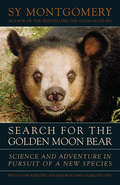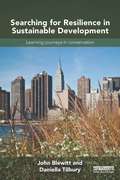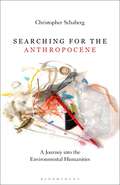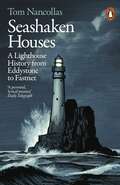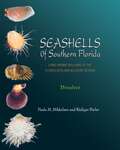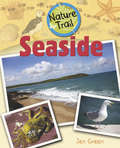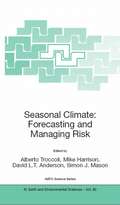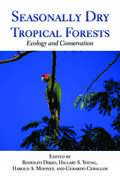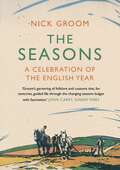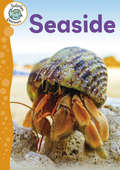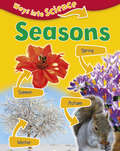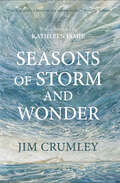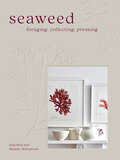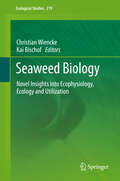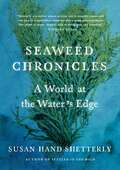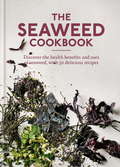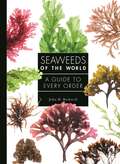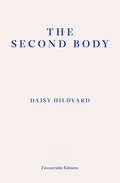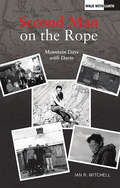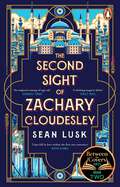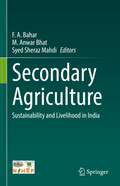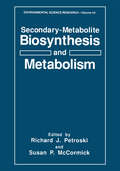- Table View
- List View
Search for the Golden Moon Bear: Science and Adventure in Pursuit of a New Species
by Sy Montgomery Gary GalbreathSy Montgomery--acclaimed author of The Soul of an Octopus and bestselling memoir The Good Good Pig--has shared with readers her amazing encounters with intelligent octopi, great apes, man-eating tigers, and pink river dolphins, but here her muse is an animal whose name and appearance evoke another world altogether. Southeast Asia's golden moon bear, with its luminous coat, lionlike mane, and Mickey Mouse ears, was unknown to science--until Montgomery and her colleagues got on the trail at the dawn of the new millennium. Search for the Golden Moon Bear recounts Montgomery's quest--fraught with danger and mayhem--to reconstruct an evolutionary record and piece together a living portrait of her littleknown subject. This beautiful animal is not just a scientific eureka! It is also a powerful symbol of conservation. Search for the Golden Moon Bear is a field report from the frontiers of science and the ends of the earth, seamlessly weaving together folklore, natural history, and contemporary research into fantastic travelogue.
Searching for Resilience in Sustainable Development: Learning Journeys in Conservation
by John Blewitt Daniella TilburyResilience is a term that is gaining currency in conservation and sustainable development, though its meaning and value in this context is yet to be defined. Searching for Resilience in Sustainable Development examines ways in which resilience may be created within the web of ecological, socio-economic and cultural systems that make up the world in. The authors embark upon a learning journey exploring both robust and fragile systems and asking questions of groups and individuals actively involved in building or maintaining resilience. Through a series of wide ranging interviews the authors give voice to the many different approaches to thinking of and building resilience that may otherwise stay rooted in and confined by specific disciplinary, professional or spatial contexts. The book documents emerging trends, shifting tactics and future pathways for the conservation and sustainable development movement post Rio+20, arriving at a set of diverse but connected conclusions and questions in relation to the resilience of people and planet. This book is ideal for students and researchers working in the fields of conservation, sustainable development, education, systems thinking and development studies. It will also be of great interest to NGOs and government officers whose interests and responsibilities focus on conserving or reconstructing biodiversity and system resilience.
Searching for Resilience in Sustainable Development: Learning Journeys in Conservation
by John Blewitt Daniella TilburyResilience is a term that is gaining currency in conservation and sustainable development, though its meaning and value in this context is yet to be defined. Searching for Resilience in Sustainable Development examines ways in which resilience may be created within the web of ecological, socio-economic and cultural systems that make up the world in. The authors embark upon a learning journey exploring both robust and fragile systems and asking questions of groups and individuals actively involved in building or maintaining resilience. Through a series of wide ranging interviews the authors give voice to the many different approaches to thinking of and building resilience that may otherwise stay rooted in and confined by specific disciplinary, professional or spatial contexts. The book documents emerging trends, shifting tactics and future pathways for the conservation and sustainable development movement post Rio+20, arriving at a set of diverse but connected conclusions and questions in relation to the resilience of people and planet. This book is ideal for students and researchers working in the fields of conservation, sustainable development, education, systems thinking and development studies. It will also be of great interest to NGOs and government officers whose interests and responsibilities focus on conserving or reconstructing biodiversity and system resilience.
Searching for the Anthropocene: A Journey into the Environmental Humanities
by Christopher SchabergDebated, denied, unheard of, encompassing: The Anthropocene is a vexed topic, and requires interdisciplinary imagination. Starting at the author's home in rural northern Michigan and zooming out to perceive a dizzying global matrix, Christopher Schaberg invites readers on an atmospheric, impressionistic adventure with the environmental humanities. Searching for the Anthropocene blends personal narrative, cultural criticism, and ecological thought to ponder human-driven catastrophe on a planetary scale.This book is not about defining or settling the Anthropocene, but rather about articulating what it's like to live in the Anthropocene, to live with a sense of its nagging presence--even as the stakes grow higher with each passing year, each oncoming storm.
Searching for the Anthropocene: A Journey into the Environmental Humanities
by Christopher SchabergDebated, denied, unheard of, encompassing: The Anthropocene is a vexed topic, and requires interdisciplinary imagination. Starting at the author's home in rural northern Michigan and zooming out to perceive a dizzying global matrix, Christopher Schaberg invites readers on an atmospheric, impressionistic adventure with the environmental humanities. Searching for the Anthropocene blends personal narrative, cultural criticism, and ecological thought to ponder human-driven catastrophe on a planetary scale.This book is not about defining or settling the Anthropocene, but rather about articulating what it's like to live in the Anthropocene, to live with a sense of its nagging presence--even as the stakes grow higher with each passing year, each oncoming storm.
Seashaken Houses: A Lighthouse History from Eddystone to Fastnet
by Tom NancollasLighthouses are striking totems of our relationship to the sea. For many, they encapsulate a romantic vision of solitary homes amongst the waves, but their original purpose is much more utilitarian than that. Still today we depend upon their guiding lights for the safe passage of ships. Nowhere is this truer than in the rock lighthouses of Great Britain and Ireland, a ring of 19 towers built between 1811-1905, so-called because they were constructed on desolate rock formations in the middle of the sea, and made of granite to withstand the power of its waves.Seashaken Houses is a lyrical exploration of these singular towers, the people who risked their lives building and rebuilding them, those that inhabited their circular rooms, and the ways in which we value emblems of our history in a changing world.
Seashells of Southern Florida: Living Marine Mollusks of the Florida Keys and Adjacent Regions: Bivalves
by Paula M. Mikkelsen Rüdiger BielerLocated where the Atlantic Ocean, Gulf of Mexico, and Caribbean Sea converge, the Florida Keys are distinctive for their rich and varied marine fauna. The Keys are home to nearly sixty taxonomic families of bivalves such as clams and mussels--roughly half the world's bivalve family diversity. The first in a series of three volumes on the molluscan fauna of the Keys and adjacent regions, Seashells of Southern Florida: Bivalves provides a comprehensive treatment of these bivalves, and also serves as a comparative anatomical guide to bivalve diversity worldwide. Paula Mikkelsen and Rüdiger Bieler cover more than three hundred species of bivalves, including clams, scallops, oysters, mussels, shipworms, jewel boxes, tellins, and many lesser-known groups. For each family they select an exemplar species and illustrate its shell and anatomical features in detail. They describe habitat and other relevant information, and accompany each species account with high-resolution shell photographs of other family members. Text and images combine to present species--to family-level characteristics in a complete way never before seen. The book includes fifteen hundred mostly color photographs and images of shells, underwater habitats, bivalves in situ, original anatomical and hinge drawings, scanning electron micrographs, and unique transparent--shell illustrations with major organ systems color-coded and clearly shown. Seashells of Southern Florida: Bivalves is the most complete guide to subtropical bivalves available. It is an essential tool for students and teachers of molluscan diversity and systematics, and an indispensable identification guide for collectors, scuba divers, naturalists, environmental consultants, and natural-resource managers.
Seaside: Seaside (Nature Trail #3)
by Jen GreenThe purpose of this series is to show children the habitats around them. The books will guide a child through their personal exploration of different habitats. The reader will be encouraged to use key science skills to plan, observe, collect, record and and preserve their findings on their trail of nature.
Seasonal Climate: Forecasting and Managing Risk (Nato Science Series: IV: #82)
by Alberto Troccoli Mike Harrison David L. T. Anderson Simon J. MasonOriginally formed around a set of lectures presented at a NATO Advanced Study Institute (ASI), this book has grown to become organised and presented rather more as a textbook than as a standard "collection of proceedings". This therefore is the first unified reference ‘textbook’ in seasonal to interannual climate predictions and their practical uses. Written by some of the world’s leading experts, the book covers a rapidly-developing science of prime social concern.
Seasonally Dry Tropical Forests: Ecology and Conservation
by Rodolfo Dirzo, Hillary S. Young, Harold A. Mooney and Gerardo CeballosSeasonally Dry Tropical Forests brings together a range of experts in diverse fields including biology, ecology, biogeography, and biogeochemistry, to review, synthesize, and explain the current state of our collective knowledge on the ecology and conservation of this endangered ecosystem. The book offers a synthetic and cross-disciplinary review of recent work with an expansive scope, including sections on distribution, diversity, ecosystem function, and human impacts. Throughout, contributors emphasize conservation issues, particularly emerging threats and promising solutions, with key chapters on climate change, fragmentation, restoration, ecosystem services, and sustainable use. Seasonally dry tropical forests represent scientific terrain that is poorly explored, and there is an urgent need for increased understanding. This book represents an important step in bringing together the most current scientific information about this vital ecosystem.
The Seasons: A Celebration of the English Year
by Professor Nick GroomShortlisted for the Katharine Briggs Folklore Award and runner-up for Countryfile Book of the Year. For millennia, the passing seasons and their rhythms have marked our progress through the year. But what do they mean to us now that we lead increasingly atomised and urban lives and our weather becomes ever more unpredictable or extreme?In this splendidly rich and lyrical celebration of the English seasons, Nick Groom investigates the trove of strange folklore and often stranger fact they have accumulated over the centuries and shows how tradition and our links with nature still have a vital role to play in all our lives.
Seasons: Seasons (Tadpoles Learners #4)
by Annabelle LynchLook outside. What's the weather like today? Find out how the different seasons change the world around us, from snowy winter to sunny summer. Tadpoles Learners are an ideal introduction to non-fiction for beginner readers, blending accessible text with big, striking photos.
Seasons (Ways Into Science #6)
by Peter RileyA first science series that introduces young readers to basic science principles in a friendly and accessible way. Early scientific skills are taught through a combination of experiments, activities and key questions, designed to get young scientists thinking!Seasons explore what the different seasons are and how they change the world around us.
Seasons of Storm and Wonder
by Jim CrumleyFrom Jim Crumley, the "pre-eminent Scottish nature-writer” (Guardian), this landmark volume documents the extraordinary natural life of the Scottish Highlands and bears witness to the toll climate chaos is already taking on our wildlife, habitats and biodiversity – laying bare what is at stake for future generations. A display of head-turning autumn finery on Skye provokes Jim Crumley to contemplate both the glories of the season and how far the seasons themselves have shapeshifted since his early days observing his natural surroundings. After a lifetime immersed in Scotland's landscapes and enriched by occasional forays in other northern lands, Jim has amassed knowledge, insight and a bank of memorable imagery chronicling the wonder, tumult and spectacle of nature’s seasonal transformations. He has witnessed not only nature’s unparalleled beauty, but also how climate chaos and humankind has brought unwanted drama to wildlife and widespread destruction of ecosystems and habitats. In this landmark volume, Jim combines lyrical prose and passionate eloquence to lay bare the impact of global warming and urge us all towards a more daring conservation vision that embraces everything from the mountain treeline to a second spring for the wolf.
Seaweed: Foraging, Collecting, Pressing
by Melanie Molesworth Julia BirdA gorgeous guide to foraging, pressing and using seaweeds for a wealth of home creative projects. Both aspirational and inspirational, this guide to bringing the outdoors inside is quite unlike anything on the market and will inspire all readers to begin their beach foraging journey.
Seaweed Biology: Novel Insights into Ecophysiology, Ecology and Utilization (Ecological Studies #219)
by Christian Wiencke and Kai BischofSeaweeds, also known as macroalgae, are among the most important primary producers and act as ecological engineers on rocky coasts of the world’s oceans. In addition to their extreme ecological importance they are also of high economic relevance. Complementing available textbooks with its more research-oriented approach, this volume contains 22 chapters by renowned experts, grouped in five parts. In Part I fundamental processes and acclimation strategies of seaweeds towards the abiotic environment are covered. Part II focuses on the multitude of biotic interactions in seaweed communities, and in Part III the reader is introduced to the structure and function of the main seaweed systems of the world. The chapters of Part IV highlight and discuss the effects of global and local environmental changes on seaweeds and their communities. In the final Part V a comprehensive overview of developments in seaweed aquaculture, industrial applications and the overall economic importance of seaweeds is provided. Summarizing the advances in seaweed biology achieved within the last few decades, this book also identifies gaps in the present knowledge and needs for future research.
Seaweed Chronicles: A World at the Water's Edge
by Susan Hand Shetterly&“You might not expect unfettered passion on the topic of seaweed, but Shetterly is such a great storyteller that you find yourself following along eagerly.&” —Mark Kurlansky &“Seaweed is ancient and basic, a testament to the tenacious beginnings of life on earth,&” writes Susan Hand Shetterly in this elegant, fascinating book. &“Why wouldn&’t seaweeds be a protean life source for the lives that have evolved since?&” On a planet facing environmental change and diminishing natural resources, seaweed is increasingly important as a source of food and as a fundamental part of our global ecosystem. In Seaweed Chronicles, Shetterly takes readers deep into the world of this essential organism by providing an immersive, often poetic look at life on the rugged shores of her beloved Gulf of Maine, where the growth and harvesting of seaweed is becoming a major industry. While examining the life cycle of seaweed and its place in the environment, she tells the stories of the men and women who farm and harvest it—and who are fighting to protect this critical species against forces both natural and man-made. Ideal for readers of such books as The Hidden Life of Trees and How to Read Water, Seaweed Chronicles is a deeply informative look at a little understood and too often unappreciated part of our habitat.
The Seaweed Cookbook: Discover the health benefits and uses of seaweed, with 50 delicious recipes
by AsterWhile seaweed remains a core culinary ingredient in Asia, these traditions are enjoying a resurgence across the world, from California to Cornwall, Norway, Sweden and Denmark.Seaweed is one of nature's healthiest foods. Rich in vitamin B12, it is particularly good for vegans as this vitamin is usually found in animal sources. It also contains iodine, which helps promote a healthy metabolism.A little seaweed goes a long way and so it is perfect as a seasoning, whether in salt or infused in oils and dressings. It can be used to flavour both sweet and savoury, from broths, salads and stews to scones, shortbread, chocolate and granola. And because it is so good for our skin, there will also be recipes for body scrubs, seaweed soaks and masks.
Seaweeds of the World: A Guide to Every Order (A Guide to Every Family #4)
by John BothwellA lavishly illustrated guide to the seaweed families of the worldSeaweeds are astoundingly diverse. They're found along the shallows of beaches and have been recorded living at depths of more than 800 feet; they can be microscopic or grow into giants many meters long. They’re incredibly efficient at using the materials found in the ocean and are increasingly used in the human world, in applications from food to fuel. They’re beautiful, too, with their undulating shapes anchored to the sea floor or drifting on the surface. Seaweeds aren’t plants: they’re algae, part of a huge and largely unfamiliar group of aquatic organisms. Seaweeds of the World makes sense of their complicated world, differentiating between the three main groups—red, green, and brown—and delving into their complex reproductive systems. The result is an unprecedented, accessible, and in-depth look at a previously hidden ocean world.Features close to 250 beautiful color photos as well as diagrams and distribution mapsCovers every major family and genus
The Second Body
by Daisy HildyardEvery living thing has two bodies. To be an animal is to be in possession of a physical body, a body which can eat, drink and sleep; it is also to be embedded in a worldwide network of ecosystems. When every human body has an uncanny global presence, how do we live with ourselves? In this timely and elegant essay, Daisy Hildyard captures the second body by exploring how the human is part of animal life. She meets Richard, a butcher in Yorkshire, and sees pigs turned into boiled ham; and Gina, an environmental criminologist, who tells her about leopards and silver foxes kept as pets in luxury apartments. She speaks to Luis, a biologist, about the origin of life; and talks to Nadezhda about fungi in an effort to understand how we define animal life. Eventually, her second body comes to visit her first body when the river flooded her home last year. The Second Body is a brilliantly lucid account of the dissolving boundaries between all life on earth.
Second Man on the Rope: Mountain Days with Davie
by Ian R. MitchellWhat are the rules of etiquette in a bothy full of strangers?How cold, exactly, can a Scottish summer get?And how many cans of beer can a man carry whilst fording a swollen river?Second Man on the Rope tackles all these questions and more, a celebrating Scotland’s mountains come sun, sleet or snow, through the stories of a great climbing partnership.Ranging from the Cairngorms to Glencoe, from Nevis to Knoydart and from the Cuillin to the Cobbler, this book weaves the story of a friendship amongst witty – and often alarming – tales of mountaineering mishaps. These richly entertaining tales will delight all who love the Scottish hills – be they mountaineers, day-outers, Munro-baggers (like the author) or merely armchair ramblers.Written with a wealth of knowledge, this mountaineering classic is a warm and witty celebration of friendship, forged over many years, between the author and his ‘first man’ – Davie. Together they form one of the great double acts of climbing literature. They face with humour and fortitude all that the mountains can pit against them – winter avalanches, raging rivers, rats in bothies and Brummies in baseball boots.
The Second Sight of Zachary Cloudesley: The spellbinding tale of one young man’s quest for the truth in 18th century London and Constantinople
by Sean Lusk'One of the best books I've read this year. Atmospheric, engaging, and elegantly written, this amazing tale of a clockmaker whose son possesses unusual talents is completely unforgettable...' Sunday Times bestselling author, Bonnie Garmus'Fans of eccentrically flavoured historical fiction with a touch of magic are in for a treat' Metro For fans of The Essex Serpent, The Night Circus and The Personal History of David CopperfieldZachary Cloudesley is gifted in a remarkable way. But not all gifts are a blessing...Leadenhall Street, London, 1754.Raised amongst the cogs and springs of his father's workshop, Zachary Cloudesley has grown up surrounded by strange and enchanting clockwork automata. He is a happy child, beloved by his father Abel and the workmen who help bring his father's creations to life.He is also the bearer of an extraordinary gift; at the touch of a hand, Zachary can see into the hearts and minds of the people he meets.But then a near-fatal accident will take Zachary away from the workshop and his family. His father will have to make a journey to Constantinople that he will never return from. And, years later, only Zachary can find out what happened.A beautifully crafted historical mystery that will take the reader from 18th century London, across Europe and, finally, to the bustling city of Constantinople. What readers are saying:'an excellent historical, magical realist novel''beautifully written''full of love and humour''original and rich in historical detail''my best book of 2022''totally engrossing...unforgettable'
Second Site (POINT: Essays on Architecture #4)
by James NisbetA meditation on how environmental change and the passage of time transform the meaning of site-specific artIn the decades after World War II, artists and designers of the land art movement used the natural landscape to create monumental site-specific artworks. Second Site offers a powerful meditation on how environmental change and the passage of time alter and transform the meanings—and sometimes appearances—of works created to inhabit a specific place.James Nisbet offers fresh approaches to well-known artworks by Ant Farm, Rebecca Belmore, Nancy Holt, Richard Serra, and Robert Smithson. He also examines the work of less recognized artists such as Agnes Denes, Bonnie Devine, and herman de vries. Nisbet tracks the vicissitudes wrought by climate change and urban development on site-specific artworks, taking readers from the plains of Amarillo, Texas, to a field of volcanic rock in Mexico City, to abandoned quarries in Finland.Providing vital perspectives on what it means to endure in an ecologically volatile world, Second Site challenges long-held beliefs about the permanency of site-based art, with implications for the understanding and conservation of artistic creation and cultural heritage.
Secondary Agriculture: Sustainability and Livelihood in India
by F. A. Bahar M. Anwar Bhat Syed Sheraz MahdiThis book on ‘Secondary Agriculture’ discusses the goal of doubling farmers’ incomes. The term ‘secondary’ has a bearing on climate change adaptation and its mitigation, small farm viability and profitability, food security, nutrition, sustainable utilization of natural resources, and optimal usage of produce from primary agriculture and farm incomes. Promoting secondary agriculture has implications on attaining sustainable development goals, which aim to connect primary, secondary and tertiary sectors by using slack/idle factors of production, such as land and labour, contributing to primary agriculture production, capturing ‘value’ in primary agricultural activities, and generating additional income at the enterprise level. In context to same, the chapters of this book have been designed to promote secondary agriculture through low-cost skills and technology applications in agriculture and by upscaling knowledge via integrating primary, secondary and tertiary sectors of agriculture. The motivation behind this book is to address the challenges of biotic and abiotic stresses facing the farming community; to increase farmers income through low-cost skills and technology applications in agriculture; to upscale knowledge by integrating primary, secondary and tertiary sectors of agriculture. The food processing sector in India is still in a nascent stage with only 8 per cent of the produce being processed as against 80-98 per cent in case of high-income countries (Government of India, 2008, 2010). The food processing sector is now receiving the boost with the annual growth of 13.2 per cent in registered food processing units during 2004-10 (Government of India, 2011). Against this backdrop, there is a strong need to strategically handle the situation in order to facilitate a self-sustainable and long-run growth of the sector, which is felt possible by focusing on Secondary Agriculture. Though not a panacea for all ailments of the primary sector, but it can definitely drive the growth.
Secondary-Metabolite Biosynthesis and Metabolism (Environmental Science Research #44)
by Richard J. Petroski Susan P. McCormickThis book was developed from the proceedings of the American Chemical Society, Division of Agricultural & Food Chemistry, subdivision of Natural Products Symposium "Biosynthesis and Metabolism of Secondary Natural Products" held in Atlanta, Georgia, April 1991. The objective of the conference was to bring together people from apparently diverse fields, ranging from biotechnology, metabolism, mechanistic organic chemistry, enzymology, fermentation, and biosynthesis, but who share a common interest in either the biosynthesis or the metabolism of natural products. It is our intention to help bridge the gap between the fields of mechanistic bio-organic chemistry and biotechnology. Our thanks go to Dr. Henry Yokoyama, co-organizer of the symposium, the authors who so kindly contributed chapters, the conference participants, and to those who assisted in the peer review process. We also thank the financial supporters of the symposium: ACS/AGFD, NIH General Medical Sciences, and the agricultural, pharmaceutical, biotechnology, and chromatography companies. A full list of the supporting corporations and institutions is given on the following page. Pharma-Tech and P.C., Inc. are manufacturers of instrumentation for high-speed countercurrent chromatography. We thank the Agricultural Research Service and the U. S. Department of Agriculture for granting me permission to co-organize the conference and for us to complete the book. Richard J. Petroski Susan P. McCormick USDA, ARS, National Center for Agricultural Utilization Research Peoria, IL 61604 June 10, 1992 vii CONTENTS ANTIBIOTICS Polyketide Synthetases: Enzyme Complexes and Multifunctional Proteins Directing the Biosynthesis of Bacterial Metabolites from Fatty Acids. . . . . . . . . . . . . . . . . . . . . . . . . . . . . . . 3 . . . . . . . . . . .
